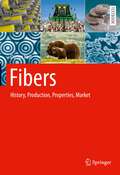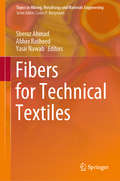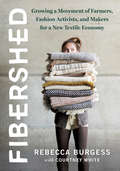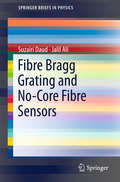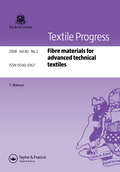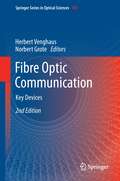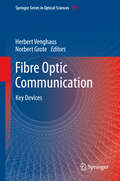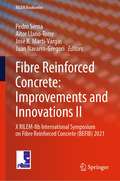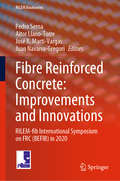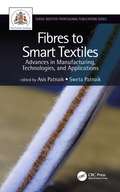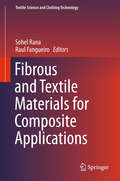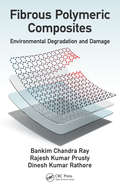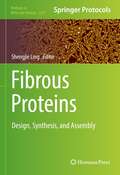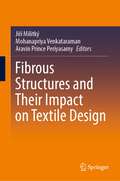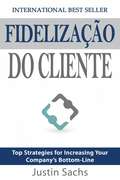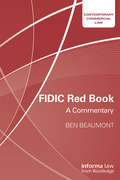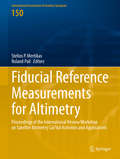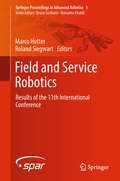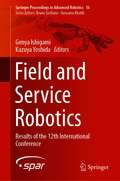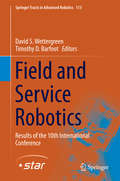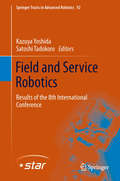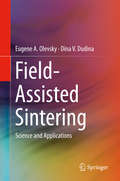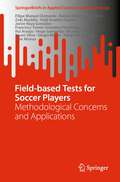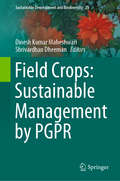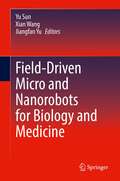- Table View
- List View
Fibers: History, Production, Properties, Market
by Dieter VeitThis textbook covers the production of all relevant natural and man-made fibers, their inner structure, properties, applications, markets and historic development. More than 1,600 photos, maps and sketches complement the text. The properties of important fibers are compared in a large number of tables and graphics to simplify selecting an appropriate fiber for a given application.
Fibers for Technical Textiles (Topics in Mining, Metallurgy and Materials Engineering)
by Sheraz Ahmad Abher Rasheed Yasir NawabThis book discusses the properties of fibres used in manufacturing technical textiles, highlighting the importance of material selection in terms of cost, end-user requirements and properties. It also discusses the classification of technical textiles, and describes the details of each category, such as the properties, applications, advantages and drawbacks. As such, it is a valuable resource for all those interested in advanced textiles.
Fibershed: The Growing Movement For A New System Of Local Clothing Production And Slow Fashion
by Rebecca Burgess Courtney WhiteThere is a major disconnect between what we wear and our knowledge of its impact on land, air, water, labor, and human health. Even those who value access to safe, local, nutritious food have largely overlooked the production of fiber, dyes, and the chemistry that forms the backbone of modern textile production. While humans are 100 percent reliant on their second skin, it’s common to think little about the biological and human cultural context from which our clothing derives. <P><P> Almost a decade ago, weaver and natural dyer Rebecca Burgess developed a project focused on wearing clothing made from fiber grown, woven, and sewn within her bioregion of North Central California. As she began to network with ranchers, farmers, and artisans, she discovered that even in her home community there was ample raw material being grown to support a new regional textile economy with deep roots in climate change prevention and soil restoration. A vision for the future came into focus, combining right livelihoods and a textile system based on economic justice and soil carbon enhancing practices. Burgess saw that we could create viable supply chains of clothing that could become the new standard in a world looking to solve the climate crisis. <P><P> In Fibershed readers will learn how natural plant dyes and fibers such as wool, cotton, hemp, and flax can be grown and processed as part of a scalable, restorative agricultural system. They will also learn about milling and other technical systems needed to make regional textile production possible. Fibershed is a resource for fiber farmers, ranchers, contract grazers, weavers, knitters, slow-fashion entrepreneurs, soil activists, and conscious consumers who want to join or create their own fibershed and topple outdated and toxic systems of exploitation..
Fibre Bragg Grating and No-Core Fibre Sensors (SpringerBriefs in Physics)
by Suzairi Daud Jalil AliThis book focuses on the development and set-up of fibre Bragg grating (FBG) and no-core fibre (NCF) sensors. It discusses the properties of the sensors and modelling of the resulting devices, which include electronic, optoelectronic, photovoltaic, and spintronic devices. In addition to providing detailed explanations of the properties of FBG and NCF sensors, it features a wealth of instructive illustrations and tables, helping to visualize the respective devices’ functions.
Fibre Materials for Advanced Technical Textiles (Textile Progress #No. 27)
by T. MatsuoThis paper tries to give an overview on technologies using fibrous materials for contributing to environmental and resource matters. The technologies for water treatment include bio-reactive treatment system using membrane hollow fibre, desalination using Ro hollow fibre, purification of water work using UF or MF hollow fibre, purification of recyc
Fibre Optic Communication: Key Devices (Springer Series in Optical Sciences #161)
by Norbert Grote Herbert VenghausThe book gives an in-depth description of key devices of current and next generation fibre optic communication networks. Devices treated include semiconductor lasers, optical amplifiers, modulators, wavelength filters and other passives, detectors, all-optical switches, but relevant properties of optical fibres and network aspects are included as well. The presentations include the physical principles underlying the various devices, technologies used for their realization, typical performance characteristics and limitations, but development trends towards more advanced components are also illustrated. This new edition of a successful book was expanded and updated extensively. The new edition covers among others lasers for optical communication, optical switches, hybrid integration, monolithic integration and silicon photonics. The main focus is on Indium phosphide-based structures but silicon photonics is included as well. The book covers relevant principles, state-of-the-art implementations, status of current research as well as expected future components.
Fibre Optic Communication
by Herbert Venghaus Norbert GroteThe book gives an in-depth description of the key devices of current and next generation fibre optic communication networks. In particular, the book covers devices such as semiconductor lasers, optical amplifiers, modulators, wavelength filters, and detectors but the relevant properties of optical fibres as well. The presentations include the physical principles underlying the various devices, the technologies used for the realization of the different devices, typical performance characteristics and limitations, and development trends towards more advanced components are also illustrated. Thus the scope of the book spans relevant principles, state-of-the-art implementations, the status of current research and expected future components.
Fibre Reinforced Concrete: X RILEM-fib International Symposium on Fibre Reinforced Concrete (BEFIB) 2021 (RILEM Bookseries #36)
by Pedro Serna Aitor Llano-Torre José R. Martí-Vargas Juan Navarro-GregoriThis volume highlights the latest advances, innovations, and applications in the field of fibre-reinforced concrete (FRC), as presented by scientists and engineers at the RILEM-fib X International Symposium on Fibre Reinforced Concrete (BEFIB), held in Valencia, Spain, on September 20-22, 2021. It discusses a diverse range of topics concerning FRC: technological aspects, nanotechnologies related with FRC, mechanical properties, long-term properties, analytical and numerical models, structural design, codes and standards, quality control, case studies, Textile-Reinforced Concrete, Geopolymers and UHPFRC. After the symposium postponement in 2020, this new volume concludes the publication of the research works and knowledge of FRC in the frame of BEFIB from 2020 to 2021 with the successful celebration of the hybrid symposium BEFIB 2021. The contributions present traditional and new ideas that will open novel research directions and foster multidisciplinary collaboration between different specialists.
Fibre Reinforced Concrete: RILEM-fib International Symposium on FRC (BEFIB) in 2020 (RILEM Bookseries #30)
by Pedro Serna Aitor Llano-Torre José R. Martí-Vargas Juan Navarro-GregoriThis volume highlights the latest advances, innovations, and applications in the field of fibre reinforced concrete (FRC) and discusses a diverse range of topics concerning FRC: rheology and early-age properties, mechanical properties, codes and standards, long-term properties, durability, analytical and numerical models, quality control, structural and Industrial applications, smart FRC’s, nanotechnologies related to FRC, textile reinforced concrete, structural design and UHPFRC. The contributions present improved traditional and new ideas that will open novel research directions and foster multidisciplinary collaboration between different specialists. Although the symposium was postponed, the book gathers peer-reviewed papers selected in 2020 for the RILEM-fib International Symposium on Fibre Reinforced Concrete (BEFIB).
Fibres to Smart Textiles: Advances in Manufacturing, Technologies, and Applications (Textile Institute Professional Publications)
by Asis Patnaik Sweta PatnaikFibres to Smart Textiles: Advances in Manufacturing, Technologies, and Applications offers comprehensive coverage of the fundamentals and advances in the textile and clothing manufacturing sectors. It describes the basics of fibres, yarns, and fabrics and their end use in the latest developments and applications in the field and addresses environmental impacts from textile processes and how to minimize them. This book serves as a single comprehensive source discussing textile fibres, yarn formation, filament formation techniques, woven fabric formation, knitting technologies, nonwoven manufacturing technologies, braiding technologies, and dyeing, printing, and finishing processes. Testing of textile materials, environmental impacts of textile processes and use of CAD and CAM in designing textile products are also included. The book also discusses applications including textile composites and biocomposites, technical textiles, smart textiles, and nanotextiles. With chapters authored by textile experts, this practical book offers guidance to professionals in textile and clothing manufacturing and shows how to avoid potential pitfalls in product development.
Fibrous and Textile Materials for Composite Applications
by Sohel Rana Raul FangueiroThis bookfocuses on the fibers and textiles used in composite materials. It presentsboth existing technologies currently used in commercial applications and thelatest advanced research and developments. It also discusses the differentfiber forms and architectures, such as short fibers, unidirectional tows,directionally oriented structures or advanced 2D- and 3D-textile structures that are used in composite materials. In addition, it examinesvarious synthetic, natural and metallic fibers that are used to reinforcepolymeric, cementitious and metallic matrices, as well as fiber properties,special functionalities, manufacturing processes, and composite processing andproperties. Two entire chapters are dedicated to advanced nanofiber andnanotube reinforced composite materials. The book goes on to highlightdifferent surface treatments and finishes that are applied to improvefiber/matrix interfaces and other essential composite properties. Although a great deal of information about fibers and textilestructures used for composite applications is already available, this is theonly book currently available that discusses all types of fibers and structuresused to reinforce polymers, cement, metal or soil to improve their generalperformance and multi-functional behaviors. As such, it fills an important gapin the available literature and provides a valuable resource for a wide rangeof students and researchers from academia and industry.
Fibrous Polymeric Composites: Environmental Degradation and Damage
by Bankim Ray Rajesh Prusty Dinesh RathoreThis book emphasizes the scientific origin of deformation and damage of FRP composites under various environmental effects and analyses present understanding on degradation mechanisms, role of interfaces and addition of nanofillers Discusses micro-characterization of composites and interfaces, also includes micro-mechanisms and microscopic evidences to establish the structure-property correlation Elucidates advantages and limitations of FRP composites in supercritical applications
Fibrous Proteins: Design, Synthesis, and Assembly (Methods in Molecular Biology #2347)
by Shengjie LingThis detailed volume explores fibrous proteins widely present in different biological tissues or biological structural materials. The book begins by introducing the structure of representative fibrous proteins, including animal silks, collagen, elastin, resilin, and keratin, and it then continues by providing detailed experimental protocols for the synthesis, assembly, and characterization of natural, regenerated, and recombinant fibrous proteins. Written for the highly successful Methods in Molecular Biology series, chapters include introductions to their respective topics, lists of the necessary materials and reagents, step-by-step, readily reproducible laboratory protocols, and tips on troubleshooting and avoiding known pitfalls. Authoritative and practical, Fibrous Proteins: Design, Synthesis, and Assembly is an ideal guide for researchers aiming to master fibrous protein preparations with the aid of this broad and interdisciplinary perspective on understanding the structure-property-function relationships of natural and reconstituted fibrous proteins.
Fibrous Structures and Their Impact on Textile Design
by Jiří Militký Mohanapriya Venkataraman Aravin Prince PeriyasamyBooks on Textiles tend to focus solely on aesthetic or technical points of view. Designers’ understanding of special technical aspects of textile structure or the ability of researchers to grasp the design aspects would result in quantum leaps in innovations and creativity in the Textile domain. This book presents a holistic view integrating the viewpoints of designers and researchers. It presents previously unexplored features or possibilities, mainly in the field of textile structure constructions and characteristics. The main aim is a unique proper blending of both the technical and aesthetic sides of textile. Without compromising on the technicalities, it simplifies complex concepts to elevate the understanding of fashion designers. On the other hand, it also provides a viewpoint on aesthetics. The chapters are designed to provide a good balance of content for both fashion designers and professionals. The initial chapter sets the foundation of understanding with a healthy discussion about the latest technical trends of textiles’ functionalities and their new applications. A dedicated chapter discusses the practical use of lighting effects of side-emitting optical fibers in conjunction with color effects for textile design purposes. Further chapters deal with smart textiles design in the context of sensation and perception, basic aspects of textiles structures necessary for their rational design, and color characteristics of materials useful for designers. The book includes a special chapter on analyzing the business landscape of textile design. Overall, this book is expected to cater to the needs and give special knowledge important for both textile specialists and fashion designers.
Fidelização Do Cliente
by Justin Sachs Bianca Busato PortellaFidelização do Cliente fornece as melhores ferramentas, estratégias e princípios dos melhores profissionais de negócios estratégicos do mundo. Trata-se de sistemas e práticas que empreendedores e líderes de empresas reais utilizam diariamente nos seus negócios para aumentar a fidelização do cliente e o valor do tempo de vida geral de seus clientes.
FIDIC Red Book: A Commentary (Contemporary Commercial Law)
by Ben BeaumontWritten by a member of the FIDIC President’s List of Adjudicators, this detailed and critical commentary on the FIDIC Red Book provides authoritative guidance and recommendations for best practice. Focusing on each Clause of the Condition of Contract, this book identifies pitfalls and logistics issues associated with its enforcement and ancillary processes, to give readers an advantage when operating with the FIDIC Red Book. Intended to promote the best use and growth of FIDIC, this guide will be essential for all users of the FIDIC Red Book, be they contractors, lawyers, engineers, students training to join these industries or any professional involved in the resolution of disputes involving the FIDIC Red Book.
Fiducial Reference Measurements for Altimetry: Proceedings of the International Review Workshop on Satellite Altimetry Cal/Val Activities and Applications (International Association of Geodesy Symposia #150)
by Stelios P. Mertikas Roland PailThese proceedings include selected papers from the International Review Workshop on Satellite Altimetry Cal/Val Activities and Applications, held in Chania, Crete, Greece, on 23-26 April 2018. Organised in the context of the European Space Agency Project “Fiducial Reference Measurements for Altimetry” the workshop was cosponsored by the International Association of Geodesy (in particular by the IAG Commission 2, Gravity Field), the European Space Agency, the European Union (the Copernicus Programme), the European Organisation for the Exploitation of Meteorological Satellites (EUMETSAT), Space Geomatica P.C., and the Municipality of Chania.The workshop presented the latest research in the field of satellite altimetry calibration and altimetry applications for monitoring ocean changes and improving Earth observation in an objective, continuous, homogeneous and reliable manner, free of errors and biases. Further, it supported long-term monitoring of climate change by providing a better understanding of environmental changes in the world's oceans, terrestrial surface waters, and Arctic and Antarctic Regions. The outcome was the creation of a scientific roadmap with procedures, protocols, guidelines, and best practices to help international groups working on satellite altimetry to establish SI (Système International d'Unités) traceability of their measurements, results and data products.
Field and Service Robotics
by Marco Hutter Roland SiegwartThis books presents the results of the 6th edition of "Field and Service Robotics" FSR03, held in Chamonix, France, July 2007. The conference provided a forum for researchers, professionals and robot manufacturers to exchange up-to-date technical knowledge and experience. This book offers a collection of a broad range of topics including: Underwater Robots and Systems, Autonomous Navigation for Unmanned Aerial Vehicles, Simultaneous Localization and Mapping, and Climbing Robotics.
Field and Service Robotics: Results of the 12th International Conference (Springer Proceedings in Advanced Robotics #16)
by Genya Ishigami Kazuya YoshidaThis book comprises select proceedings of the 12th Conference on Field and Service Robotics (FSR 2019) focusing on cutting-edge research carried out in different applications of robotics, including agriculture, search and rescue, aerial marine, industrial, and space. It focuses on experiments and demonstrations of robotics applied to complex and dynamic environments and covers diverse applications. The essays are written by leading international experts, making it a valuable resource for researchers and practicing engineers alike.
Field and Service Robotics
by David S. Wettergreen Timothy D. BarfootThis bookcontains the proceedings of the 10th FSR, (Field and Service Robotics) which isthe leading single-track conference on applications of robotics in challengingenvironments. The 10th FSR was held in Toronto, Canada from 23-26June 2015. The book contains 42full-length, peer-reviewed papers organized into a variety of topics: Aquatic, Vision, Planetary, Aerial,Underground, and Systems. The goal ofthe book and the conference is to report and encourage the development andexperimental evaluation of field and service robots, and to generate a vibrantexchange and discussion in the community. Field robots are non-factory robots, typically mobile, that operate incomplex and dynamic environments: on theground (Earth or other planets), under the ground, underwater, in the air or inspace. Service robots are those thatwork closely with humans to help them with their lives. The first FSR was held in Canberra,Australia, in 1997. Since that firstmeeting, FSR has been held roughly every two years, cycling through Asia,Americas, Europe.
Field and Service Robotics
by Kazuya Yoshida Satoshi TadokoroFSR, the International Conference on Field and Service Robotics, is the leading single track conference of robotics for field and service applications. This book presents the results of FSR2012, the eighth conference of Field and Service Robotics, which was originally planned for 2011 with the venue of Matsushima in Tohoku region of Japan. However, on March 11, 2011, a magnitude M9. 0 earthquake occurred off the Pacific coast of Tohoku, and a large-scale disaster was caused by the Tsunami which resulted, therefore the conference was postponed by one year to July, 2012. In fact, this earthquake raised issues concerning the contribution of field and service robotics technology to emergency scenarios. A number of precious lessons were learned from operation of robots in the resulting, very real and challenging, disaster environments. Up-to-date study on disaster response, relief and recovery was then featured in the conference. This book offers 43 papers on a broad range of topics including: Disaster Response, Service/Entertainment Robots, Inspection/Maintenance Robots, Mobile Robot Navigation, Agricultural Robots, Robots for Excavation, Planetary Exploration, Large Area Mapping, SLAM for Outdoor Robots, and Elemental Technology for Mobile Robots.
Field-Assisted Sintering: Science and Applications
by Eugene A. Olevsky Dina V. DudinaThis book represents the first ever scientific monograph including an in-depth analysis of all major field-assisted sintering techniques. Until now, the electromagnetic field-assisted technologies of materials processing were lacking a systematic and generalized description in one fundamental publication; this work promotes the development of generalized concepts and of comparative analyses in this emerging area of materials fabrication. This book describes modern technologies for the powder processing-based fabrication of advanced materials. New approaches for the development of well-tailored and stable structures are thoroughly discussed. Since the potential of traditional thermo-mechanical methods of material treatment is limited due to inadequate control during processing, the book addresses ways to more accurately control the resultant material's structure and properties by an assisting application of electro-magnetic fields. The book describes resistance sintering, high-voltage consolidation, sintering by low-voltage electric pulses (including spark plasma sintering), flash sintering, microwave sintering, induction heating sintering, magnetic pulse compaction and other field-assisted sintering techniques. Includes an in-depth analysis of all major field-assisted sintering techniques;Explains new techniques and approaches for material treatment;Provides detailed descriptions of spark plasma sintering, microwave sintering, high-voltage consolidation, magnetic pulse compaction, and various other approaches when field-assisted treatment is applied.
Field-based Tests for Soccer Players: Methodological Concerns and Applications (SpringerBriefs in Applied Sciences and Technology)
by Filipe Manuel Clemente Rafael Oliveira Rui Silva Zeki Akyildiz Halil Ibrahim Ceylan Javier Raya González Francisco Tomás Fernández Rui Araújo Hugo Sarmento Ricardo Lima Bruno Silva Sérgio Matos Yung-Sheng Chen José AfonsoThis book systematically summarizes the accuracy, precision, and repeatability levels of field-based tests applied in soccer. It considers such details as the effectiveness of tests for different age categories and sexes. In this book, the readers will be able to check all the field-based tests conceived for fitness assessment in soccer through a large systematic review made to the literature. In addition a brief characterization of each test and presentation of the concurrent validity and repeatability levels for each test will be provided. Finally, the book contains a general discussion of the implications of the tests for different methodological approaches to training. It will be use to sports scientists and practitioners.
Field Crops: Sustainable Management by PGPR (Sustainable Development and Biodiversity #23)
by Dinesh Kumar Maheshwari Shrivardhan DheemanThis book discusses the most challenging task ahead of researchers from India and around the globe: providing disease-free field crops for the ever-growing world population. In Asia, despite being cultivated in massive volumes, major crops, including cereals, oil seed, tuber and non-tuber vegetables, and fruit, are not meeting the demands of the increasing population. This book showcases naturally occurring beneficial microbes in the form of plant growth promoting rhizobacteria, or PGPR, which make it possible to grow field crops without applying synthetic chemicals.Our understanding of PGPR has increased exponentially in recent decades. They play a multifarious role in developing sustainable systems of crop production and protection. The book focuses on the mechanistic behaviors of PGPRs, their use to develop sustainable cultivation techniques, and their application to enhance crop growth and productivity at the cutting edge of tech-oriented agriculture and to replace hazardous chemicals with microbial inoculants. The book is useful to agronomists, microbiologists, ecologists, plant pathologists, molecular biologists, environmentalists, policy makers, conservationists, and NGOs working on organically grown field crops.
Field-Driven Micro and Nanorobots for Biology and Medicine
by Yu Sun Xian Wang Jiangfan YuThis book describes the substantial progress recently made in the development of micro and nanorobotic systems, utilizing magnetic, optical, acoustic, electrical, and other actuation fields. It covers several areas of micro and nanorobotics including robotics, materials science, and biomedical engineering. Field-Driven Micro and Nanorobots for Biology and Medicine provides readers with fundamental physics at the micro and nano scales, state-of-the-art technical advances in field-driven micro and nanorobots, and applications in biological and biomedical disciplines.
